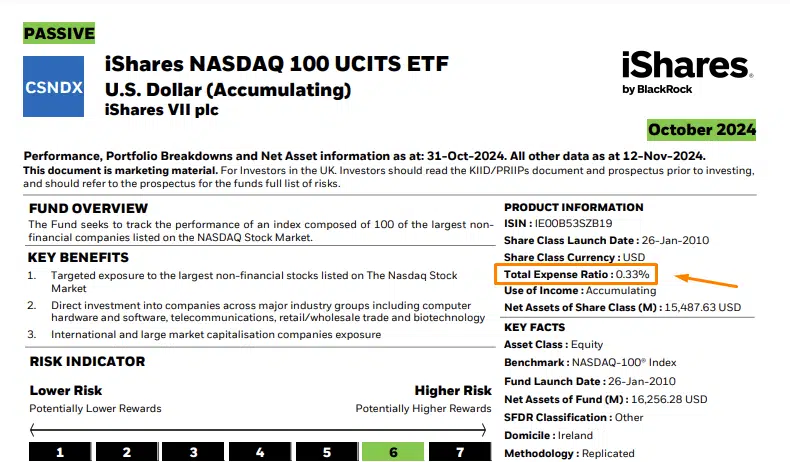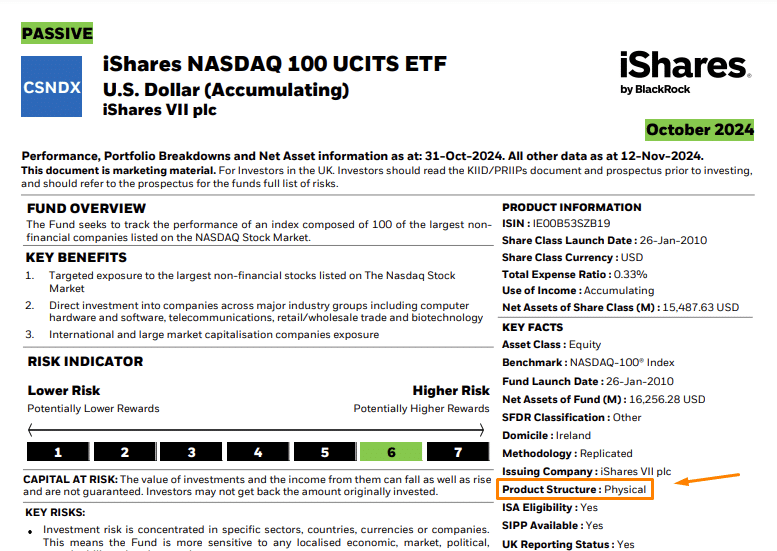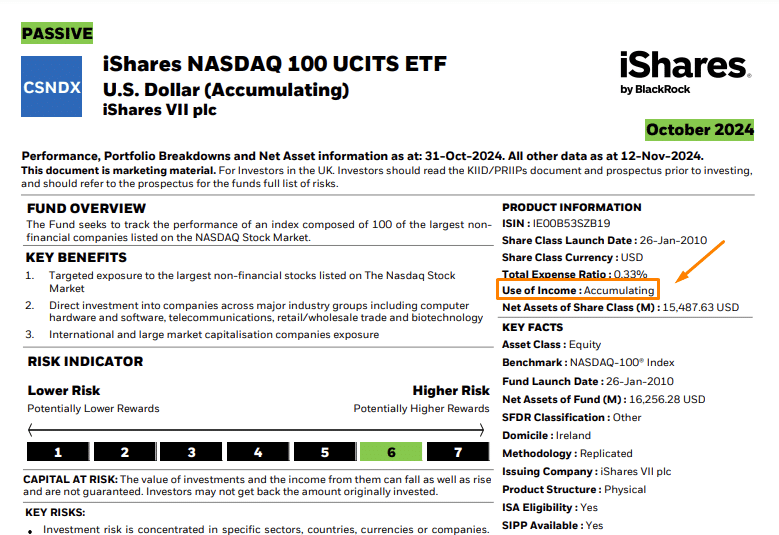The Invesco QQQ ETF (QQQ is the ticker symbol) offers investors a simple way to diversify across the U.S. stock market.
However, due to regulatory restrictions, QQQ isn’t directly accessible to retail investors in Europe and the UK.
In this article, we will explore the availability of QQQ in Europe and the UK, alternative ETFs, and guidance on how to invest in these alternatives.
Why QQQ isn’t directly available in Europe & UK?
QQQ, a popular US-domiciled ETF, isn’t directly available to European and UK investors due to regulatory constraints under the EU’s Packaged Retail and Insurance-based Investment Products (PRIIPs) regulation.
This regulation requires that investment products marketed to retail investors in the EU must provide a Key Information Document (KID), which outlines the product’s features, risks, and costs in a standardized format. The PRIIP regulation aims to enhance transparency and protect retail investors by ensuring they have access to transparent and comparable information about investment products.
US-domiciled ETFs like QQQ do not produce these KIDs because US regulations do not mandate such disclosures. Consequently, these ETFs do not comply with PRIIPs requirements and are therefore inaccessible to ordinary retail investors on European investment platforms such as eToro, DEGIRO, Interactive Brokers, Trading 212, and Trade Republic.
Furthermore, QQQ is quoted in USD, while the European and UK equivalent ETFs are quoted in other currencies, such as the EUR and the GBP (explored below).
For further details, refer to the official documentation of the PRIIPs regulation provided by the European Union here.
Disclaimer: Investing involves risk of loss.
Is there any workaround to invest in QQQ?
Investors in Europe and the UK looking to gain exposure to QQQ have some alternatives available. One is through Contracts for Difference (CFDs) on platforms like eToro. CFDs allow you to speculate on QQQ’s price movements without owning the underlying ETF physically. However, this approach comes with significant risks, including higher potential losses if leverage is used.
What are CFDs?
CFDs are financial instruments that enable traders to take positions on price changes in an underlying asset, like the Nasdaq-100®, without owning it. It contrasts with traditional investing, where ownership of the asset is required. To learn more about the differences between CFDs and investing in real assets, read our article: CFDs vs Shares: Understand the Differences.
Another option is investing in other ETFs replicating the same underlying index as QQQ, the Nasdaq-100®. These ETFs are designed to track the performance of the Nasdaq-100® Index, providing similar exposure to the index without needing to invest directly in QQQ.
How to buy QQQ ETF CFD on eToro
If you are a European or UK investor and you want to buy the QQQ ETF CFD on eToro, you need to:
a) Search for QQQ ETF CFD:
- In the eToro search bar, type “QQQ” or “Invesco QQQ”.
- Select the QQQ ETF CFD instrument from the search results.
b) Open a trade:
- Click the “Trade” button on the QQQ CFD instrument page. It will open the order window.
c) Set your trade parameters:
- Amount or number of shares: Enter the amount of money you want to invest in or the number of shares;
- Leverage: Choose your desired leverage level (remember, leverage can amplify gains and losses);
- Stop Loss and Take Profit: Set these optional orders if you want to manage your risk. A stop-loss order automatically closes your trade if the price drops to a certain level, while a take-profit order closes it when the price reaches a specified target.
d) Execute the trade:
- Carefully review your order details to ensure they are correct.
- Click the “Buy” button to execute your buy order.
Best QQQ alternatives for European and UK investors
There’s no need to worry for EU and UK investors seeking exposure to the Nasdaq-100® without taking on the high risk associated with CFDs.
We’ve compiled a selection of alternative ETFs that offer a secure and regulated way to tap into the U.S. market’s potential. These UCITS-compliant funds provide diversified exposure to the 100 largest non-financial companies listed on the NASDAQ stock exchange, all within your region’s regulatory framework.
The following tables showcase some of the most popular options available for European and UK investors. The first table shows ETFs quoted in Euros, while the second one is in British Pounds.
QQQ Equivalent ETFs in Europe (€EUR)
In Europe, one of the most popular QQQ ETF equivalents is the SXRV ETF, as it has the largest fund size. Below is a table with some of the leading European ETFs based on data from justETF.com:
| Name | Ticker | ISIN | Annual Fee (TER) | Replication Method | Use of Income | Fund Size (in €B) |
| iShares Nasdaq 100 UCITS ETF | SXRV | IE00B53SZB19 | 0.33% | Physical | Accumulating | €13+ |
| Invesco EQQQ Nasdaq-100 UCITS ETF | EQQQ | IE0032077012 | 0.30% | Physical | Distributing | €6+ |
| Amundi Nasdaq-100 II UCITS ETF | LYMS | LU1829221024 | 0.22% | Synthetic | Accumulating | €2+ |
| Invesco EQQQ Nasdaq-100 UCITS ETF | EQQB | IE00BFZXGZ54 | 0.30% | Physical | Accumulating | €2+ |
UK equivalent ETFs of QQQ (£GBP)
In Europe, one of the most popular QQQ ETF equivalents is the CNX1 ETF, as it has the largest fund size. Below is a table with some of the leading European ETFs based on data from justETF.com:
| Name | Ticker | ISIN | Annual Fee (TER) | Replication Method | Use of Income | Fund Size (in £B) |
| iShares Nasdaq 100 UCITS ETF | CNX1 | IE00B53SZB19 | 0.33% | Physical | Accumulating | £11+ |
| Invesco EQQQ Nasdaq-100 UCITS ETF | EQQQ | IE0032077012 | 0.30% | Physical | Distributing | £5+ |
| Amundi Nasdaq-100 II UCITS ETF | NASL | LU1829221024 | 0.22% | Synthetic | Accumulating | £2+ |
| Xtrackers Nasdaq 100 UCITS ETF 1C | XNAQ | IE00BMFKG444 | 0.20% | Physical | Accumulating | £0.5+ |
How to buy QQQ alternative (SXRV) on DEGIRO
If you’re looking to invest in an alternative to the QQQ ETF in EUR, the iShares Nasdaq 100 UCITS ETF (SXRV) is a great option, as it is the ETF in EUR with the largest amount of investment. Below are the steps to purchase the SXRV ETF on DEGIRO:
a) Search for SXRV and select it:
- In the DEGIRO app, type “SXRV” in the search bar.
- Select the iShares Nasdaq 100 UCITS ETF from the search results.
b) Open a trade:
- Click the “Buy” button on the SXRV ETF page to open the order window.
c) Set trade parameters:
- Enter the number of shares you wish to purchase. You can also set additional parameters such as market, limit, stop loss, stop limit, and trailing stop orders as needed.
d) Execute the trade:
- Review your order details to ensure everything is correct. Click “Place Order” to execute your purchase.
By following these steps, you can easily invest in the iShares Nasdaq 100 UCITS ETF (SXRV) on DEGIRO, gaining exposure to the Nasdaq-100® index within a regulated framework suitable for European investors.
What to look for in a Nasdaq-100® ETF (in EUR and GBP)?
When evaluating an ETF, it’s crucial to consider several factors to ensure it meets your investment goals and strategy. Here are the key points to keep in mind:
a) Fees
Management fees for ETFs can vary depending on the provider. These fees are often referred to as Ongoing Charges Figure (OCF) or Total Expense Ratio (TER), as is the case with iShares by BlackRock.
Taking the iShares Nasdaq 100 UCITS ETF (SXRV) fact sheet as an example, you can verify the TER is 0.33%:
b) Replication method
ETFs can use different methods to replicate the performance of the Nasdaq-100® index:
- Physical Replication: This method involves holding the actual securities that comprise the index, providing direct exposure to it, and avoiding the complexities associated with derivatives.
- Synthetic Replication: This approach uses financial derivatives to replicate index performance, which can be more cost-effective but introduces counterparty risk if the derivative contracts fail.
The iShares Nasdaq 100 UCITS ETF (SXRV) uses physical replication, holding the actual stocks of the Nasdaq-100® Index, which is generally preferred for its straightforward approach and transparency:
c) Use of income
ETFs handle income from underlying assets in different ways:
- Accumulating ETFs: These ETFs reinvest dividends from the holdings back into the fund, potentially boosting returns through compounding.
- Distributing ETFs: These ETFs pay out dividends to shareholders periodically, providing a regular income stream but potentially being less tax-efficient in certain jurisdictions.
The best choice depends on your individual preferences and financial goals. An accumulating ETF might be more suitable if you’re focused on long-term growth and reinvesting dividends. A distributing ETF could be a better fit if you need regular income.
The iShares Nasdaq 100 UCITS ETF (SXRV) is an accumulating ETF:
d) Size
The overall size of the ETF, measured by Total Assets, can be a factor to consider. Larger ETFs tend to have higher liquidity, meaning buying and selling shares is easier without significantly impacting the price.
SXRV has a Net Asset Value of $15,487.63 million:
e) Currency
Another important aspect is the currency in which the ETF is denominated. ETFs can be listed in different currencies such as USD, EUR, or GBP. The currency denomination of an ETF can impact your investment in the following ways:
- Currency exchange risk: If the ETF is denominated in a different currency than your base currency, you may face currency exchange risks. For example, if you are a UK investor and the ETF is denominated in USD, fluctuations in the USD/GBP exchange rate will affect your returns;
- Transaction costs: Buying an ETF in a currency different from your base currency may involve additional transaction costs due to currency conversion fees;
- Convenience: Holding an ETF in your local currency (EUR for European investors, GBP for UK investors) can simplify your portfolio management and avoid the need for frequent currency conversions.
f) Currency hedging
Currency hedging can be an important consideration for European and UK investors. Some ETFs offer versions that hedge against fluctuations between the euro or pound and the U.S. dollar.
While hedging can provide stability in the short term, it may also come with additional costs and could potentially reduce long-term returns if the euro or pound strengthens against the dollar.
Looking to backtest your ETF portfolios?
If you are an EU citizen looking to backtest your ETF portfolios, check out our Portfolio Analyser. Our tool allows you to analyze your selected portfolios and obtain visual data and metrics to make informed decisions when comparing and evaluating EU-domiciled ETFs.
Bottom Line
In summary, while QQQ isn’t directly accessible to European and UK investors due to regulatory constraints, many alternative ETFs offer similar exposure to the Nasdaq-100®.
These UCITS-compliant funds adhere to EU regulations, ensuring transparency and investor protection. By understanding the specific features of these alternatives, including fees, replication methods, income treatment, currency, and fund size, investors can make well-informed choices that align with their financial goals.
Furthermore, QQQ is quoted in USD, so it might make sense for you to invest in an equivalent ETF quoted in your home currency, in order to avoid currency conversion fees, as well as currency risk.
For European investors, options such as the SXRV and EQQQ provide benefits similar to those of QQQ within a compliant regulatory framework. British investors can access alternatives like the CNX1 and EQQQ.
Platforms such as Interactive Brokers, DEGIRO, Trading 212, and Trade Republic offer access to these ETFs, making it convenient for EU and UK investors to engage with the U.S. market.
We hope this article has addressed your questions about the availability of QQQ in Europe and the UK.
Best of luck with your investments!
















